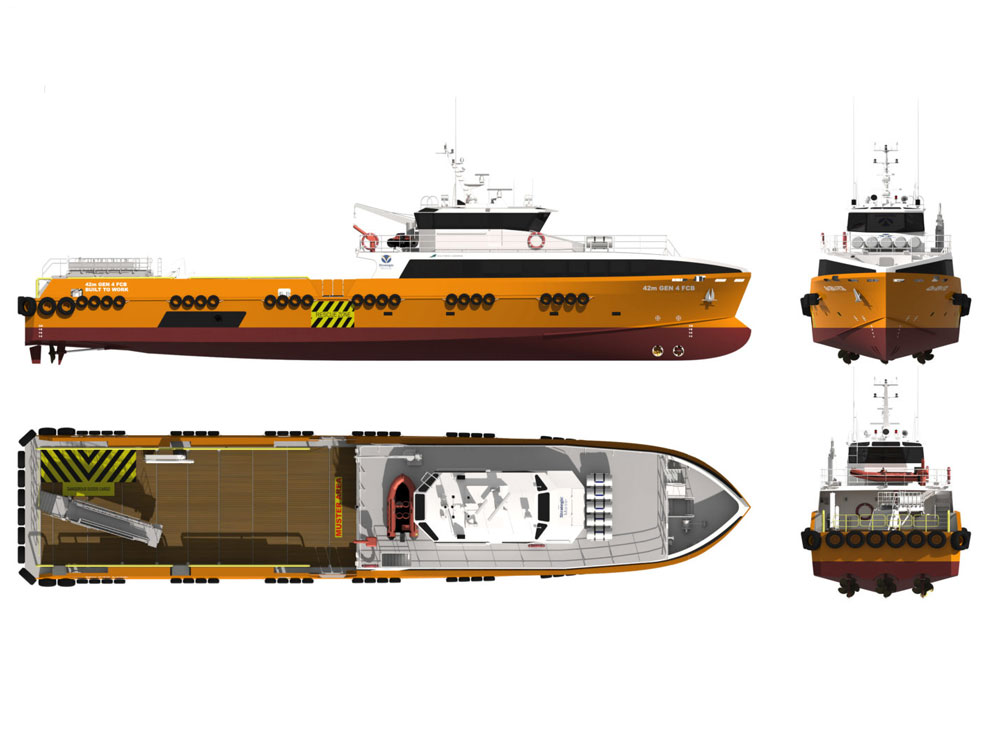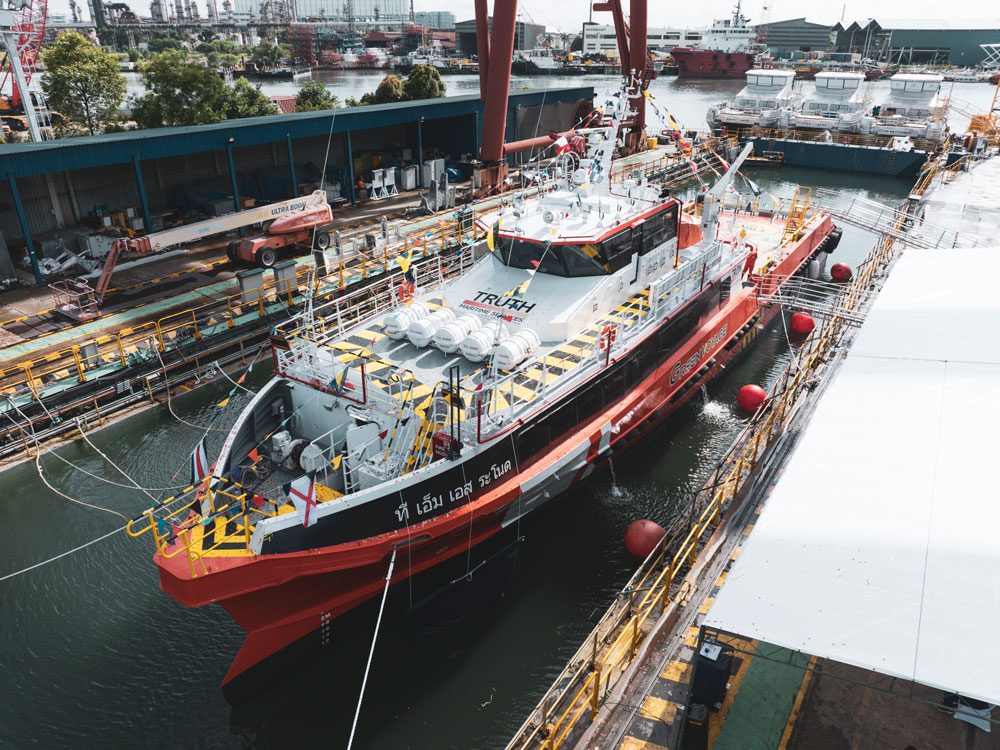The story of Thailand’s first pair of gyrostabilised, 42m-long fast crewboats (FCBs) conceals another, writes Stevie Knight: how did Southerly Designs’ FCB concept establish a perpetual offshore presence from 2001 to today’s Gen 4 models? And how is the design faring with the push toward new technology?
Southerly’s FCB concept has seen a 23-year run, with no sign of stopping. Most of these have found homes around Southeast Asia, including in Thailand, where first of two Gen 4 FCBs were recently delivered to Thailand’s Truth Maritime Services (TMS). The latter company owns a fleet of crewboats dedicated to shuttling technicians to and from offshore petroleum exploration and production platforms within the region. All of these vessels have been delivered by Singaporean boatbuilder Strategic Marine.
So, why are the FCBs perennially popular? “People sometimes think that these crewboats are not as sexy as the big OSVs, since they are basically produced for platform maintenance,” says Wayne Poh, Strategic Marine GM for commercial. However, their lack of pretension may have proven a saving grace, as these vessels’ roles are relatively unaffected by oil prices. “Whether it’s a good time or a bad time in the industry, you still have to send technicians to the platform for servicing duties,” Poh comments. This stable demand means that any changes to the design, resulting in the new Gen 4 concept, have been carefully considered for what they would yield, and against what could be lost. For example, Southerly MD Andrew Taylor explains: “In moving from Gen 3 to Gen 4, we tried to make the hullform a little bit more efficient to get the most out of the seakeeping. While these boats aren’t generally exposed to open ocean swell, the daily wind chop can still make things quite rough.”
Taylor says that hullform efficiency can be achieved by maximising the vessel’s waterline length. Quite a few FCB designs have tried to achieve this with a completely vertical bow, but Taylor says: “We found that this makes it much more difficult to achieve the flared bow, a curvature in the top side shape and a fine entry that’s still not going to dive in too far.” The answer was a Z-bow: beyond the advantage of the longer waterline, it allows the retention of Southerly’s signature flared hull: an important element, as it yields a drier deck and more forward space for anchoring arrangements while contributing to good seakeeping qualities. In contrast to the 40.3m x 7.9m Gen 3 models, the Gen 4 measures 42m x 8.2m.

A general arrangement of the Gen 4 FCB
Various iterations of this design have had different engine combinations feeding the fixed-pitch propellers. For example, each of the FCBs delivered to TMS have a pair of Cummins KTA 38 units and a larger KTA 50, yielding a transit speed of around 27knots and a top speed of 29knots. Faster versions of the Gen 4, reaching 32knots, are possible – but these are usually the result of a “market differentiator” request by the service company, Poh says.
Shaft generators on the port and starboard engines are directly linked to a DC-bus feeding a 120kWh energy storage module. Poh says that these batteries can be a modest size yet still supply the boat’s onboard requirements, as the battery is constantly being fed by the PTOs. Although it doesn’t contribute to the propulsion, the energy storage means the onboard generators can be turned off while cruising and during limited stand-by and short harbour visits. They can then be switched on again for extended stand-by when close to the rig, and used to power the bow thrusters, cranes and/or gangways.
The challenge was that demand for extra kit increased in tandem with the Gen 4 design. For example, one of the TMS vessels is fitted with a Veem gyrostabiliser. “When the FCB is pulling up to the oil rig to carry out crew transfers, the gyrostabiliser eliminates a degree of freedom from the boat’s motion,” says Taylor. “That has a noticeable impact on the seasickness of the passengers.” However, gyrostabilisers tend to be large, measuring 2.1m on each side and about 1.2m in height. Reorganising the various tanks – making them shorter and wider – and relocating some of the other auxiliary equipment helped to free up space while retaining the necessary volume of fuel and fresh water for prolonged offshore endurance.
Designing the personnel space was also a picky business, right down to the seats, Poh explains. While there are platforms located 40-50nm from shore, “sometimes the transit can be 100nm, which is five hours of continuous steaming”, Poh highlights. The Gen 4s can accommodate 100 personnel (plus 12 crew) though, as with the TMS deliveries, these are largely being configured for 70 or 80 business-class seats and facilities, with room to adapt to client requirements.
Southerly and Strategic estimate that they have achieved an 8% reduction in hull resistance between the Gen 3 and Gen 4 designs. “Actually, we’re hearing feedback from the first Thailand delivery that they can see a significant fuel saving – up to 30% – between the new Gen 4 and the older-generation FCB they currently have working,” says Poh.
Taylor’s estimate is that, while the total hybrid package contributes around 3tonnes to the weight of the vessel, the gyrostabiliser weighs in at about 6.5tonnes. While the rear deck has been structurally prepared for motion-compensated gangways, these (and their accessories) can add another 11tonnes. That’s enough to impact efficiency, Taylor admits – but he counters: “When Gen 5 comes around, we’ll have another go at raising efficiency. I’m sure there’ll be some tweaks and lessons learned…and we might start looking into different kinds of propulsion, such as pods.”




